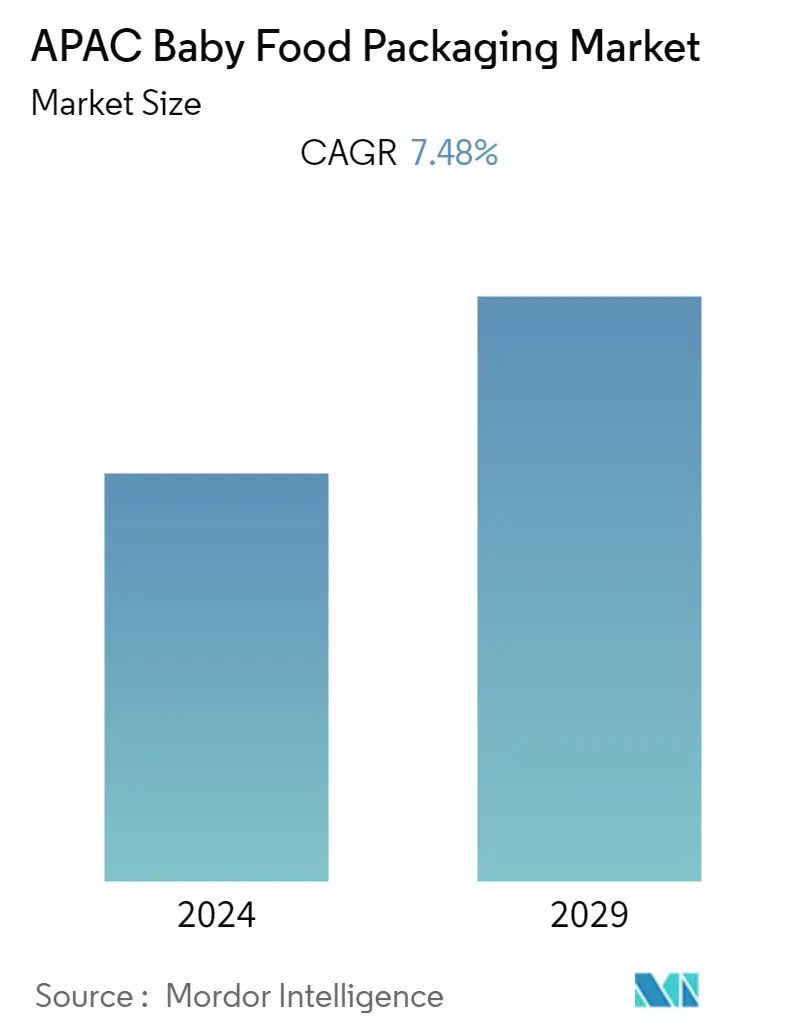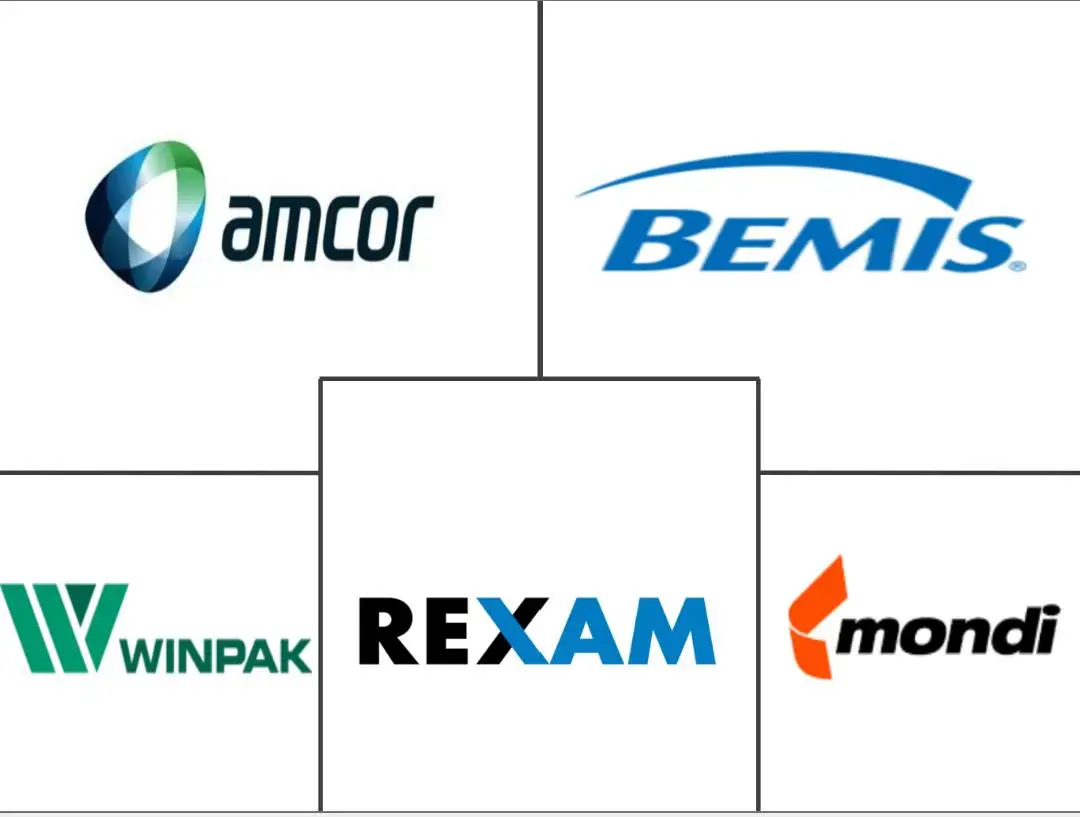Market Size of APAC Baby Food Packaging Industry

| Study Period | 2019 - 2029 |
| Base Year For Estimation | 2023 |
| Forecast Data Period | 2024 - 2029 |
| Historical Data Period | 2019 - 2022 |
| CAGR | 7.48 % |
| Market Concentration | Medium |
Major Players
*Disclaimer: Major Players sorted in no particular order |
APAC Baby Food Packaging Market Analysis
Asia Pacific Baby Food Packaging Market is expected to grow at a CAGR of 7.48% over the forecast period (2021 - 2026). The Covid-19 pandemic had a positive effect on the baby food packaging industry, as people tried to store baby food during the lockdown in the Asia Pacific region. Moreover, due to a large number of deaths (especially of new moms), the demand for baby food grew exponentially. The companies have started to meet the demand and rebalance the sustainability goals that normalize e-commerce, incorporate hygiene, redefine sustainability.
- The Asia Pacific is one of the most developed regions across the world; it is witnessing rapid urbanization leading to increased disposable income and adoption of modern lifestyle. These factors have led to an increase in the expenditure on baby food products.
- The high urbanization, growing population, increasing consumer awareness, rising disposable income, and an increasing number of women in the workforce are driving the growth of the market studied. According to the World Bank, the degree of urbanization in India rose to 34.93% in 2020 from 33.6% in 2017.
- Baby Food Packaging can be described as a coordinated system of preparing goods for transport, logistics, warehousing, use, or sale. Packaging contains, protects, preserves, transports, informs and sells.
- Another factor boosting the need for packaging solutions is the innovations by baby food manufacturers to meet the consumer's various needs. This has led the companies to create green, innovative, and recyclable products to replace normal packaging.
- Moreover, owing to some of the factors, like safe, reusable, hygienic, lightweight, and easy to carry, the stand-up pouches and thin wall containers are witnessing high demand. Thus, this is driving the market.
APAC Baby Food Packaging Industry Segmentation
Baby food packaging products are specially designed for packaging food material for infants and toddlers. A wide variety of packaging materials, such as glass jars, plastic containers, metal cans, folding cartons, and other solutions, are used for packaging baby food products, including dried foods, prepared foods, and milk formula.
The scope of the study is currently focused on Asia Pacific Region. The study tracks the key market parameters, underlying growth influencers, and major vendors operating in the industry. The study also tracks the impact of COVID-19 on the overall Asia Pacific Baby Food Packaging Market and its performance. Detailed estimates for the next five years are included, along with the study of the major players and their strategies.
| By Material | |
| Plastic | |
| Paperboard | |
| Metal | |
| Glass |
| By Package Type | |
| Bottles | |
| Metal Cans | |
| Cartons | |
| Jars | |
| Pouches | |
| Other Packaging Type |
| By Product | |
| Liquid Milk Formula | |
| Dried Baby Food | |
| Powder Milk Formula | |
| Prepared Baby Food |
| By Country | |
| China | |
| India | |
| Japan | |
| South Korea | |
| South East Asia | |
| Rest of Asia Pacific |
APAC Baby Food Packaging Market Size Summary
The Asia Pacific baby food packaging market is experiencing significant growth, driven by factors such as rapid urbanization, increasing disposable incomes, and a rise in the number of women entering the workforce. These elements have led to a higher expenditure on baby food products, with packaging playing a crucial role in ensuring the safety, convenience, and sustainability of these goods. The market has seen a shift towards innovative packaging solutions, such as stand-up pouches and thin wall containers, which are favored for their lightweight, reusable, and hygienic properties. The Covid-19 pandemic further accelerated demand as consumers sought to stock up on baby food, prompting companies to enhance their packaging strategies to meet evolving consumer needs while maintaining sustainability goals.
In the Asia Pacific region, China, Japan, and India are key players in the baby food packaging market, with China expected to hold the largest share. The growing awareness of the nutritional benefits of packaged baby food and the increasing affordability due to rising disposable incomes are propelling market growth. The market is moderately fragmented, with numerous domestic and international players competing on price, product design, and innovation. Collaborations and technological advancements, such as NFC-enabled packaging, are also contributing to the market's expansion. The focus on sustainable packaging alternatives, like recycled plastics, is expected to further drive growth, as companies strive to reduce environmental impact while meeting consumer demands for convenience and quality.
APAC Baby Food Packaging Market Size - Table of Contents
-
1. MARKET DYNAMICS
-
1.1 Market Overview
-
1.2 Assessment of Impact of COVID-19 on the Industry
-
1.3 Market Drivers
-
1.3.1 Growing Demand of Packaged Baby Food and Infant Formula
-
1.3.2 Increasing Working Women in Urban Areas residing Population
-
-
1.4 Market Restraints
-
1.4.1 Stringent Government Regulations over Single-Use Plastic-based Packaging
-
-
1.5 Industry Value Chain Analysis
-
1.6 Industry Attractiveness - Porter's Five Forces Analysis
-
1.6.1 Threat of New Entrants
-
1.6.2 Bargaining Power of Buyers
-
1.6.3 Bargaining Power of Suppliers
-
1.6.4 Threat of Substitute Products
-
1.6.5 Intensity of Competitive Rivalry
-
-
-
2. MARKET SEGMENTATION
-
2.1 By Material
-
2.1.1 Plastic
-
2.1.2 Paperboard
-
2.1.3 Metal
-
2.1.4 Glass
-
-
2.2 By Package Type
-
2.2.1 Bottles
-
2.2.2 Metal Cans
-
2.2.3 Cartons
-
2.2.4 Jars
-
2.2.5 Pouches
-
2.2.6 Other Packaging Type
-
-
2.3 By Product
-
2.3.1 Liquid Milk Formula
-
2.3.2 Dried Baby Food
-
2.3.3 Powder Milk Formula
-
2.3.4 Prepared Baby Food
-
-
2.4 By Country
-
2.4.1 China
-
2.4.2 India
-
2.4.3 Japan
-
2.4.4 South Korea
-
2.4.5 South East Asia
-
2.4.6 Rest of Asia Pacific
-
-
APAC Baby Food Packaging Market Size FAQs
What is the current APAC Baby Food Packaging Market size?
The APAC Baby Food Packaging Market is projected to register a CAGR of 7.48% during the forecast period (2024-2029)
Who are the key players in APAC Baby Food Packaging Market?
Amcor, Winpak, Mondi Group, Rexam PLC and Bemis are the major companies operating in the APAC Baby Food Packaging Market.

